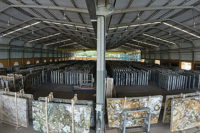Stone quarrying at Cave Bonaldi
The day began with a visit to Cave Bonaldi, a site for producing Rosso Verona marble that is considered to be one of the most historic quarry sites in the Sant’Ambrogio region. The significance of the material is evident throughout the villages surrounding the quarry, where large blocks of Rosso Verona marble were used to form centuries-old walls that still stand proudly today.
The region was not only known for its marble production, but for its stone craftsmen and artisans, and it was the birthplace of the Verona region’s internationally renowned stoneworking industry.
While the marble was traditionally found in red and white varieties, the majority of material extracted today is red with white accents. The entire region was an ocean during the Jurassic period, and the coloration of the stone comes from iron oxidation of ancient layers of soil.
The Romans started extracting Rosso Verona marble more than 2,000 years ago, and the nearby Adige River allowed blocks of material to be transported to cities such as Bologna and Modena, as well as Verona itself. The stone was also used for the dome of the Milan’s duomo.
Today, Cave Bonaldi operates its site for Rosso Verona marble — named the Calcarole quarry — using modern methods and eco-friendly practices. Exhausted areas of the quarry are revegetated, and any new sites being explored must demonstrate that they can operate for at least 30 years.
The quarry is 100 x 50 meters in size, and the production rate varies, spending on market demand. A Pellegrini stationary diamond wire saw is in place to square blocks as needed. Typically, the larger blocks are squared and used for slab production, while the smaller blocks are not squared and used for tile production. In all, the quarry yields 3,500 cubic meters of material per year.
Block sawing at Savoia Lugoboni
Many of the stoneworking plants in the Verona region of Italy are “specialists,” and an example of this can be found in Savoia Lugoboni, a division of the Testi Group. Savoia processes a range of materials, starting in block form, and it is a major producer of slabs.
The company’s block yard has an inventory of blocks from Italy and around the world, and it uses traditional gangsaws as well as state-of-the-art technology for slabbing.
Perhaps the most advanced block-sawing technology in use at Savoia is a Pellegrini DiaBlo multi-wire saw that can process blocks into slabs at an extremely high rate of speed. The saw can run up to 72 diamond wires at a time, and they move at a speed of 55 miles per hour. The wires run through the block at a rate of 10 to 15 cm per hour, depending on the material, and in addition to being much quicker than traditional gangsaws, they operate with minimal noise and material waste.
Slab processing at Combus
Another specialist in the Verona region is Combus, which processes material into finished slabs. The plant has automated technology for polishing slabs as well as applying resin.
Approximately 80% of the production at Combus is used for countertop fabrication in the U.S., and the plant processes classic materials as well as exotic materials that wouldn’t be possible to process without modern technology, such as epoxy resins that fortify fragile materials.
Combus has a full-scale automated line for applying resin production, with massive dryers that allow multiple slabs to cure quickly and simultaneously. For certain materials, however, the resin is applied by hand. In these cases, the company relies on the experience of its workers to determine which areas of each slab require increased amounts of treatment, and it ensures that the finished slabs will be as strong as possible. The resin mixture depends on the type of material being processed.
Multiple honing and polishing lines from Breton are in place at the plant, and automated vacuum lifters from Breton are used for slab handling. Overall, the plant can process up to 20,000 square feet of material per day.
Cut-to-size work at Testi
Across the U.S. and around the world, major architectural landmarks in stone have been supplied by Testi Group, with a recent example being The Smith Center for the Performing Arts, an award-winning project in Las Vegas, NV (see January 2013 Stone World, page 82).
Testi Group has multiple facilities for cut-to-size work, and they are equipped with a full range of machinery, such as bridge saws, CNC stoneworking centers, edge polishers, waterjets and more. Most important to its cut-to-size production, however, are its experienced craftsmen, who finish much of the work by hand.
Testi has “design” and “artist” components of its operation, and in addition to working with architects and designers on an international level, it also processes marble for high-end manufacturers of furnishings.

















